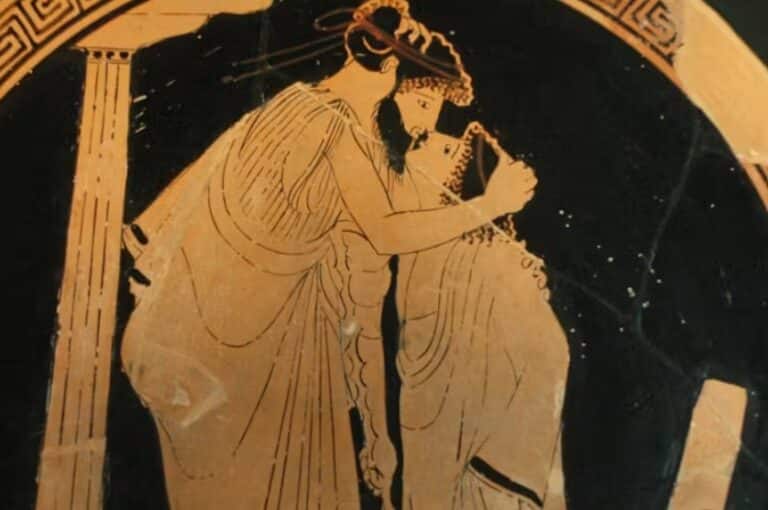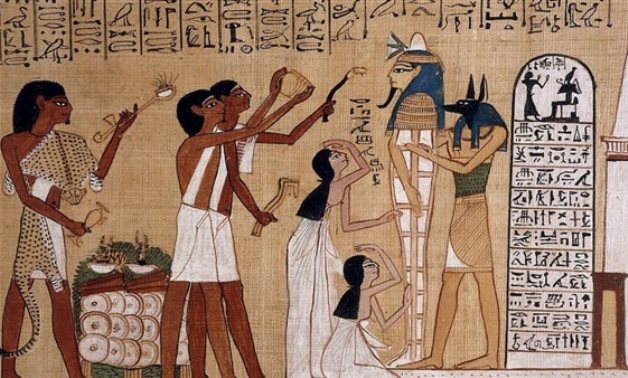People in Ancient Rome often find themselves swept up in the whirlwind of romance. This occasion, filled with chocolates and flowers, has roots in ancient traditions tied to the idea of love. In Greek and Roman mythology, love was depicted as a powerful and sometimes troublesome force. The Greeks had Eros, and the Romans followed with Cupid, small gods who were mischievous in their matchmaking.
In ancient literature, we find many varied takes on love. The Greeks offered philosophical reflections, with works like Plato’s “Symposium” delving into the nature of desire and beauty. Meanwhile, Romans such as Ovid wrote about the pursuit and challenges of love, highlighting both romantic and rather complex aspects of relationships. These stories from the past show a wide spectrum of love’s influence on society and continue to shape how we view romance today.
Key Takeaways
- Love was a significant theme in Greek and Roman mythology.
- Many ancient stories explored romantic relationships and their complexities.
- Historical perspectives on love influence modern views and celebrations.
Historical Views on Love
Mythological God of Romance
In ancient cultures like Greece and Rome, love was often seen as divine. The Greeks knew this god as Eros, while the Romans referred to him as Cupid or Amor. These mythical figures were often depicted as mischievous beings causing unexpected attractions between gods and mortals. Zeus, the chief of the Greek gods, grew tired of these unpredictable romances. Still, the image of Cupid endured, becoming popular in Roman art, leading to the motifs of cherubs seen later in history.
Plato’s Ideas in ‘Symposium’
Plato’s “Symposium” is one of the most famous ancient discussions about love. It features a series of speeches, each presenting different perspectives on Eros, the god of love. These range from ordinary rhetoric to imaginative stories, like the one by Aristophanes about humans originally having two bodies combined into one. Socrates presents the most significant speech, indicating that love is a desire for beauty, which elevates the mind to appreciate all things good. This philosophy gives rise to what we now call platonic love.
Greek Literature and Romantic Affection
Classical Greek writings often had little praise for romantic love, particularly as depicted in relationships involving young boys. On the other hand, romances involving men and women were portrayed a bit more favorably in later Greek and Roman stories. Greek novels from the Hellenistic period, for instance, are soaked in tales of innocent and awkward love. Similarly, Latin poetry, especially from writers like Catullus and Ovid, explored themes of elusive romance and complicated relationships. Ovid’s works, particularly “The Art of Love,” offered humorous guides on courtship, with advice that seems bold even by today’s standards.
Greek and Roman Literature on Love
In the world of Greek and Roman literature, the concept of love was deeply woven into myths and stories. For the Greeks, love was embodied by Eros, a whimsical god known for causing unexpected and often mismatched affection among gods and mortals. Similarly, the Romans had their own representation of love through Cupid, who was often depicted in art, multiplying into playful figures known as Erotes.
The Greeks, especially during the Hellenistic period, had a somewhat skeptical view of romantic love. Their literature typically did not celebrate romantic bonds, with some exceptions focusing on relationships between older men and younger boys. Yet, in the context of heterosexual romance, Greek novels often depicted earnest attempts at love, filled with awkward but sincere romantic pursuits.
Roman literature borrowed heavily from Greek motifs, with Latin poets like Catullus and Propertius creating works that concentrated on the elusive, often tumultuous relationships with their subjects. Ovid stands out as a significant figure among Roman love poets. His early work, “Amores,” explored the intricacies of romantic and physical relationships. “Ars Amatoria,” another of Ovid’s notable works, served as a guide to winning love. It offered advice to men on how to pursue and maintain relationships with women and later included a section for women on capturing a man’s affection.
In stark contrast, the rare voice of a female poet, Sulpicia, showed the female perspective on romance. Through passionate poems, she narrated her secretive love affair with a man, revealing challenges unique to women of her time. Furthermore, Roman daily life evidenced in places like Pompeii showed the candid and often crude expressions of love, as seen through graffiti where individuals publicly bickered over their romantic interests.
Marriage in Roman society was linked closely to love, but it was primarily seen as a social duty aimed at producing legitimate offspring. Arranged marriages were common, especially among the wealthy, where matrimony often served political or financial purposes. Love and marriage were not synonymous, yet they shared common social spaces, navigating between genuine affection and pragmatic arrangements. Even for those who sought love outside marriage, society offered solutions, ranging from long-term relationships formed by soldiers to interactions with courtesans, showcasing the diverse views on love and companionship in classical times.

Roman Love Stories and Their Fascinations
Catullus and Propertius on Longing Hearts
The poetry of Catullus and Propertius often centers around complicated relationships. These Roman poets were known for their writings about unattainable lovers. They explored themes of longing and unfulfilled desires. Their verses reflect a deep emotional attachment to women who remain out of reach, creating a blend of passion and frustration.
Catullus’ work largely focuses on an elusive woman named Lesbia. His poems express both love and torment, revealing the highs and lows of romantic pursuits. Propertius, like Catullus, writes about a woman who captivates him but remains hard to win over. In these writings, love is depicted as a pursuit filled with longing and emotional struggles.
Ovid’s Love Lessons in ‘Ars Amatoria’
Ovid’s ‘Ars Amatoria’ takes a different approach to love. This guidebook offers advice on navigating romantic relationships in Rome. Ovid crafts his tips with wit and humor, offering strategies for attracting and keeping lovers.
His advice includes visiting popular spots like theaters and circuses, suggesting these places as ideal for meeting potential partners. He recommends engaging in light conversation and building connections through shared interests. Ovid also offers tips for writing sincere love letters and emphasizes the importance of proper grooming.
The third book, later added, provides guidance to women on how to make themselves desirable to men. Ovid’s work paints a lively picture of the social dynamics of romance in ancient Rome.
Different Perspectives in Roman Poetry
Sulpicia’s Personal Tales
Sulpicia, one of the few female voices in Roman literature, brought a refreshing perspective to love and romance. Her work, written in the style of lyric poetry, captures her emotions and personal experiences. She had a passionate relationship with a man called Cerinthus. Their love, however, faced many challenges. She often had to meet him secretly at night. Despite her dedication, Cerinthus was unfaithful, having an affair with a prostitute. Sulpicia’s poetry provides a window into her emotional world, revealing the joys and pains of love from a personal angle.

Petronius’s Tale of an Entangled Romance
In Petronius’s Satyrica, there is a story of a complicated love triangle, showcasing the complexities of Roman social interactions. The narrative involves two men vying for the affections of a rebellious young boy. This relationship is depicted with undertones of deception and indulgence in pleasures such as alcohol. The story unfolds amidst a wild celebration dedicated to the god Priapus. This depiction reflects the morally ambiguous and often chaotic aspects of romantic relationships in Roman culture.
Love and Marriage in Ancient Rome
Arranged Matches in Prominent Roman Families
In high-status Roman families, marriages were often arranged to secure political and economic advantages. Fathers held significant influence, although not legal power, over their children’s marriage choices. These alliances were sometimes decided when the children were still very young, reflecting the importance placed on family and societal connections.
Romantic and Practical Unions Among the Middle Class
For middle-class Romans, marriages could be both arranged and based on love. Many families still considered the social and financial benefits of a match, yet records from Egyptian papyri show that some marriages started as love-based partnerships. These unions might have provided a more personal foundation compared to the purely strategic alliances of the elite.
Sibling Marriages in Egypt
In Roman Egypt, sibling marriages were common for various reasons, including maintaining family wealth and property. These marriages, though unusual by modern standards, might have provided stability, as the siblings already knew each other well and shared familial bonds.

Relationships of Roman Soldiers and Civilian Life
Roman soldiers were not legally allowed to marry while in service until the time of Emperor Septimius Severus. Despite this, many formed lasting relationships with local women, leading to official unions once their service ended. Some evidence, like inscriptions on tombstones, suggests that women often accompanied soldiers throughout the Empire, indicating a level of commitment and partnership despite the restrictions.
Intertwined Stories
Graffiti in Pompeii and Rivalry of Severus and Successus
In Pompeii, a lively battle of words scratched onto a bar wall reveals the competitive spirits of two men. Severus and Successus both vied for the affection of a barmaid named Iris. Severus claimed that Iris showed him affection, perhaps due to their conversations. Successus countered with a claim of being more attractive and charming. Undeterred, Severus promptly demanded that Successus leave Iris alone. The rivalry might have warmed the hearts of passersby, but unfortunately, Iris’s thoughts on the matter were never recorded.
Prostitution’s Influence on Romance
For many Romans, romantic relationships intertwined closely with the world’s oldest profession. Soldiers, for instance, were unable to legally marry while serving. Despite this, many soldiers built long-lasting bonds with local women. These connections often became official once military commitments ended. Tombstones even show that some women traveled alongside soldiers throughout the empire. For soldiers and other free men, the interactions born from such exchanges became a common way to forge meaningful relationships.
